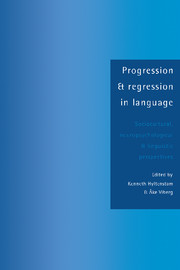 Progression and Regression in Language
Progression and Regression in Language Book contents
1 - Linguistic progression and regression: an introduction
Published online by Cambridge University Press: 06 July 2010
Summary
BASIC ASSUMPTIONS
The dynamics of language
Our physical and social environment has provided a rich source of metaphors for linguistics. Most of us, for example, are familiar with ways of talking about languages where they are depicted as living organisms – languages are born, they grow, develop, and die. We may conceive of languages as being more or less distantly related to each other – they have parents and sisters – and they share no genetics with unrelated languages.
Also other, and perhaps more abstract, characteristics of language can be highlighted and brought to the forefront of linguistic consciousness through the use of metaphors. The linguistic phenomenon that is the topic of this volume is often characterized as dynamism. Dynamism, of course, is a metaphor taken from natural sciences. In parallel with air or water (aerodynamics, hydrodynamics), language can be seen as inherently dynamic, something that exhibits change and flux, and is characterized by motion resulting from ‘natural’ forces. Only languages such as Latin, that have ceased to ‘live’, are static and fossilized. Living languages are in a continuous motion, adapting to the social contexts in which they are used; they take form as different registers or lects, they appear in the written or spoken mode, and, above all, they move with time, changing chronologically. A specific instance of chronological change occurs in the individual. When languages are acquired or lost, they adapt to the successively changing constraints of the speaker's mind and to the conditions of the social environment.
- Type
- Chapter
- Information
- Progression and Regression in LanguageSociocultural, Neuropsychological and Linguistic Perspectives, pp. 3 - 36Publisher: Cambridge University PressPrint publication year: 1994
- 4
- Cited by
